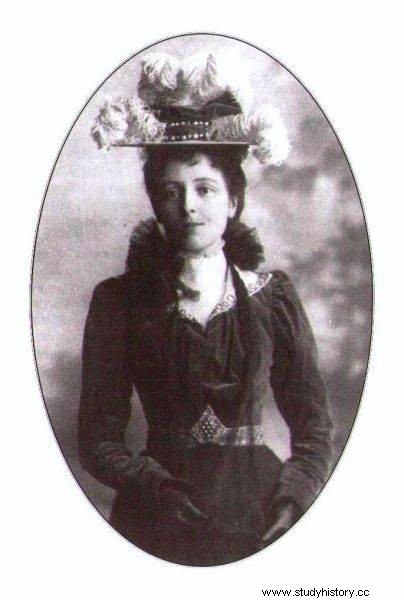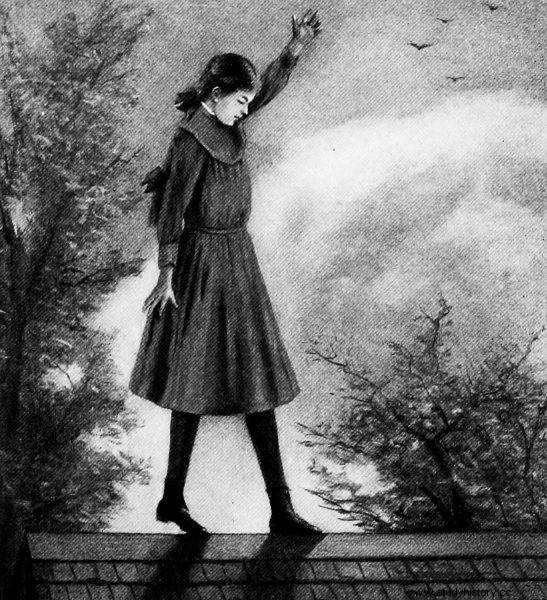"Anne of Green Gables" is known all over the world. Few people know that for her author writing was an escape from the depression that led her to her death.
Lucy Maud Montgomery was born on November 30, 1874 in Clifton, Prince Edward Island. Before she was two, her mother, Clara Woolner Macneill, died of tuberculosis. The event had a heavy impact on the future writer's father, Hugh Montgomery. Not coping with the loss of his beloved, he left his daughter in the care of his in-laws, and he himself left for the west of the country to make a new life there. During the first years he visited the girl quite regularly, but that changed when he remarried. The new wife was not eager to raise a child of hers, so the girl stayed with her mother's family.
Little Maud (she hated the name Lucy) went to live in her grandparents' home in Cavendish, Prince Edward Island. Her new guardians were not outspoken people. The girl was brought up by them in a cool and quite conservative way. Nevertheless, in her childhood years there was no shortage of family warmth and love. She met them from her aunt, Anna Campbell, who lives nearby with her family.
Ambitious lady
Maud turned out to be a diligent student. She almost absorbed her knowledge, and from the age of 9 she spent her free time writing poems and a journal. It is he and the letters to his relatives who will later discover the true face of the beloved Canadian writer, destroying the image built on the superficial reception of her work. When Montgomery turned 16, she was sent to her father. However, she did not stay in his new home for long due to constant conflicts with her stepmother and lack of relations with her half-siblings. After a year, she returned to Prince Edward Island. The bitterness of that time sweetened her by the news of the first publication of her piece. In December 1890, the newspaper Prince Edward Island The Patriot printed her poem "On Cape LeForce".

In 1895 she decided to take a short break and spent a year in Halifax, Nova Scotia
After returning to Cavendish, Maud finished school and in a year earned her Honors degree for a two-year teaching course at Prince of Wales College. Then she started working in the profession, teaching successively at schools in Bideford, Belmont and Lower Bedeque. However, it was not a profession in which she felt fulfilled. On the contrary - did not like teaching and often complained about her pupils.
In 1895, she decided to take a short break and spent a year in Halifax, Nova Scotia, where she attended Dalhousie University as one of the few students to take selected courses in English Literature. She dreamed of a writing career that would allow her to live independently. And although she received the first fee during her stay in Halifax, she had to wait a while for her author's success. And this, in a way, turned out to be a disappointment for her.
Heart trouble
While at Belmont, Maud became engaged to her cousin, Edwin Simpson. It wasn't a dream relationship, however. There was no passion in him and Montgomery quickly regretted her decision. She met her real love in Lower Bedeque. It was Herman Leard, the son of the owner of the apartment she was renting. There was no shortage of passion in this relationship, but this stage in her life ended without a happy ending.
Despite Maud's feelings for the man, saw no future for herself with him . In her eyes, he was an uneducated, poor farmer . However, this parting could not get over. She welcomed his premature death in 1899 with peculiar relief, stating:"It is easier for me to think of them as deceased belonging to me, only mine because of death, as they would never have been mine in life."

photo:M.O. Hammond fonds / public domain She divided her time between housekeeping, helping her husband with work and literary activities.
In 1898 her grandfather died. True to his will, Maud ended her teaching career and returned to Cavendish, where she looked after her grandmother for the next 13 years. Before returning, she broke off her engagement to Edwin and ended her relationship with Herman. She spent her time on Prince Edward Island writing and publishing poems and short stories in Canadian and American magazines. She also went to Halifax for nine months, where she worked as a proofreader for The Daily Echo. Her family did not fully approve of her literary career, but Maud was not put off by it. In 1905, she wrote her first novel that changed her life, bringing fame, but ... also labeled her work.
"That hideous Anne"
" Anne of Green Gables ”was not warmly welcomed at the beginning. The book was rejected by all publishers, leading Montgomery to put the manuscript in a drawer. However, she returned to it after a few years, introducing corrections and sending it to other places. This time it worked. In 1908, the Boston-based publishing house not only published the novel, but immediately signed a contract with Maud for the next volumes. The adventures of the red-haired orphan, who had a vivid imagination and an extraordinary talent for getting into trouble, almost immediately became a bestseller, delighting Mark Twain himself.

"Anne of Green Gables" did not receive a warm welcome at the beginning.
Montgomery wrote the following volumes:Anne of Avonlea, Anne of the University, and Anne's Dream House. The interest was so great that two decades later she wrote unplanned sequels:"Ania z Szumiące Topoli" and "Ania z Złoty Brzeg". With each part, she got fed up with the main character, which became her trademark. "Disgusting Anne," she kept repeating.
The series contributed to her labeling as the author of children's and youth literature. She never got rid of this patch, although she tried, writing, inter alia, "The Blue Castle" for adults. And although this and her other works met with positive reception, they never succeeded in the Ania Shirley saga.
Sorrow of the soul
In 1911, Grandma Maud passed away. Four months later, the writer married the Reverend Ewan Macdonald. The couple had been secretly engaged since 1906, but for Maud it was more about reason than passion. The couple went on a honeymoon trip to Great Britain, and after their return they settled in Leaskdale, Ontario. In 1912, their first son, Chester, was born. Two years later, Maud gave birth to another child, Hugh. Unfortunately, the boy died after giving birth. By the time the writer turned 40, her youngest son, Stuart, was born.
She divided her time between running the house, helping her husband at work and literary activities. She has published 20 novels in total (including two series about the fate of Ania and Emilka), lots of stories. She continued to write poems, journals and published an autobiography. In 1923, she became the first woman in Canadian history to be elected a fellow of the British Royal Society of the Fine Arts.

The last years of her life were a time of literary successes intertwined with problems
Her life, while apparently calm and orderly, was in fact filled with pain and fear. Maud, considered a warm and cheerful person, was very sensitive. All important events reflected on its interior. She experienced her son's death very badly and the outbreak of World War I. During the Spanish epidemic, she spent 10 days in bed, fighting for her life. She survived, but lost her best friend as a result of the pandemic.
Mysterious death
The disease distanced her from her husband, who, seeing her almost dying, did not pay much attention to her. Maud even considered divorce, but finally concluded that it was not in her Christian nature . Besides, her husband himself faced his own demons, which manifested themselves in fear that after his death he would go to hell. The author therefore resorted to her imagination, creating new works. As the years passed, she suffered more and more from bouts of depression and migraines. She saw their reason in unfulfilled passions. She regretted both her marriage to Ewan and her separation from Herman. She also missed those who passed away prematurely.
The last years of her life were a time of literary successes intertwined with problems. They affected her health and appearance. Maud lost her teeth, gained weight. Family troubles with her son and husband consumed her life energy. The scales of bitterness were filled with the outbreak of World War II, the cruelty of which overwhelmed the writer.
On April 24, 1941, Lucy Maud Montgomery was found dead in her bed in Toronto. The official cause of death was coronary thrombosis, but in 2008 the writer's granddaughter suggested that as a result of chronic depression , caused, inter alia, by taking care of her mentally unstable husband , the writer died of an overdose of sedatives . She was buried on Prince Edward Island, Cavendish.
Bibliography
- Gillen, Prince Edward Island Maud:A Biography of L. M. Montgomery , Wydawnictwo Literackie, 2008.
- Geodecka, Lucy Maud Montgomery and her biggest bane. The history of the book "Anne of Green Hill" , viva.pl, 27/12/2021 (accessed:12/01/2022).
- Kazimierowska, " Ania from Zielona Gora" was the bane of her life. Lucy Maud Montgomery , zwierciadlo.pl / accessed:12.01.2022.
- Flood, Suicide secret of Anne of Green Gables author , theguardian.com, 23/09/2008 (accessed:12/01/2022.
- M. Montgomery suicide revealed , cbc.ca, 22/09/2008 / accessed:12/01/2022.
